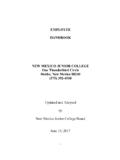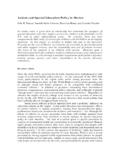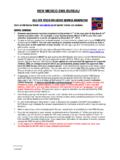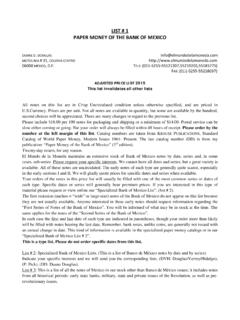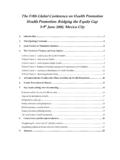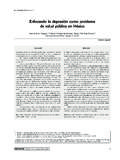Transcription of Employment Outlook 2018 - OECD.org
1 OECD Employment Outlook 2018 OECD 2018 OECD Employment Outlook publication page How does MEXICO compare? Employment Outlook 2018 July 2018 DOI: and unemployment trends in Mexico Note: OECD weighted average. Source: OECD calculations based on OECD Economic Outlook Database (No. 103), June LABOUR MARKET TRENDS AND PROSPECTS Across the OECD countries, labour market conditions continue to improve and in the first quarter of 2018, the average Employment rate was about 2 percentage points above its pre-crisis peak. OECD Employment and unemployment rates are also projected to keep improving in 2018 and 2019.
2 However, at in the fourth quarter of 2017, the year-on-year growth rate of real hourly wages remained disappointingly low, almost one percentage point lower than before the crisis for similar levels of unemployment. Employment as a share of the population aged 15-74 years has not yet recovered from the impact of the global economic crisis. It stood at in the fourth quarter of 2017, still percentage points lower than its pre-crisis level. The Employment rate is predicted to further decline through 2018 and 2019. This reflects declining labour force participation notably among youth and older workers.
3 Female labour force participation (45% in in 2017 for the age group 15-64) remains very low in comparison with other OECD countries. The unemployment rate in Mexico has further declined to in the last quarter of 2017, just below its pre-crisis level and close to 2 percentage points below the OECD average. However, this low unemployment rate partly reflects the lack of unemployment insurance system and the high incidence of informal Employment . More than half of employees and self-employed workers are informally employed. Mexico should move forward with the reform to introduce an unemployment insurance that would make formal Employment more attractive.
4 This reform has been on hold since 2014. In contrast to all other OECD countries, Mexico s significant slowdown of wage growth at the median of the wage distribution over the last decade compared to the pre-crisis period was not accompanied by a comparable slowdown also at the top. This highlights the need for policies to address the barriers people face in accessing higher-wage and better-quality jobs and reduce inequalities in the labour market. DEVELOPMENTS IN JOB QUALITY AND LABOUR MARKET INCLUSIVENESS Job quality and inclusiveness indicators show a mixed picture for the OECD countries.
5 Improvement has occurred over the past decade, with a reduction in the gender gap in labour income, the Employment gap for disadvantaged groups, and the incidence of job strain excessive job demands combined with insufficient resources. However, labour market insecurity is not yet back to pre-crisis levels and poverty has grown amongst the working-age population. Although there has been some progress in recent years, Mexico still ranks below the OECD average on many indicators of inclusiveness in the labour market. The average Employment rate of disadvantaged groups was only 40% of that of prime-age male workers in 2016.
6 This is the second highest gap among OECD countries. Poverty remains a pressing issue in Mexico. The low income rate which captures the poverty rate after taxes and transfers for the population aged 18 to 64, stood at in 2015, placing the country just behind Chile in the OECD. 5658606264%MexicoOECD246810%B. Unemployment ratePercentage of total labour forceA. Employment ratePercentage of the population aged 15-74 ProjectionsProjectionsContact: Theodora Xenogiani (+33 1 45 24 17 85; or St phane Carcillo (+33 1 45 24 80 31; Directorate for Employment , Labour and Social Affairs. OECD Employment Outlook publication page OECD Employment Outlook 2018 OECD 2018 Job quality and labour market inclusiveness: key indicators for Mexico in 2016-2017 Note: An upward (downward ) pointing arrow for an indicator means that higher (lower) values reflect better performance.))
7 Earnings quality: Gross hourly earnings in USD adjusted for inequality by giving more weight to the lower end of the earnings distribution. Labour market insecurity: Expected percentage net income loss upon job loss computed taking into account the probability of becoming unemployed and the expected duration of unemployment. Job strain: Percentage of workers in jobs with a combination of high job demands and few job resources to meet those demands. Low income rate: Share of working-age persons living with less than 50% of median equivalised household disposable income. Gender labour income gap: Difference between per capita annual earnings of men and women (% of per capita earnings of men).
8 Employment gap for disadvantaged groups: Average difference in the prime-age men's Employment rate and the rates for five disadvantaged groups (mothers with children, youth who are not in full-time education or training, workers aged 55-64, non-natives, and persons with disabilities; % of the prime-age men's rate). Source and definitions: OECD calculations using data for 2017 or latest year available from various sources. See OECD Employment Outlook 2018, Ch. 1 THE GENDER GAP IN LABOUR INCOME INCREASES THROUGHOUT THE WORKING LIFE In the OECD, women's annual labour income was still 39% lower on average than that of men in 2015. Most of this gap is generated in the first half of the career, due to the smaller number of job changes experienced by women in the early stages of their working life and around childbirth.
9 Part-time work can prevent withdrawal from the labour force at childbirth but may also represent a career trap for women, leading to persistent gender disparities. Women face many challenges in the labour in Mexico and a clear disadvantage relative to their male peers. The average annual earnings of women was lower than that of men in 2015, the third highest gender gap within the OECD. A the same time, while 79% of Mexican men had a job in 2017, only of their women peers were in Employment , one of the lowest figures in the OECD. This gender difference in Employment explains more than 70% of gender disparities in earnings in Mexico.
10 Gender gaps in Employment in Mexico remain high until retirement age. As a result, a considerable share of women in Mexico never receives a pension. In addition, a significant share of Mexican women never enters the labour market. Nonetheless, female Employment has risen in recent years and among the younger cohorts, mainly reflecting the rising educational attainment and the drop in fertility among Mexican women. Mexico should continue its efforts to increase the supply of good-quality public child care and invest further to ensure that young women have an early start in the labour market.










